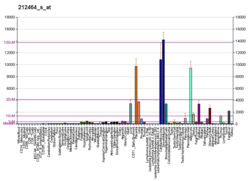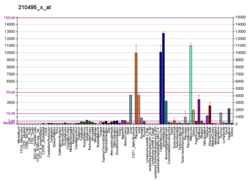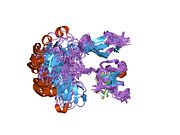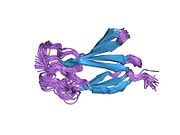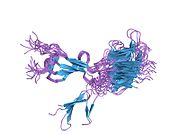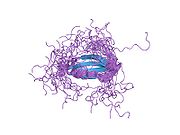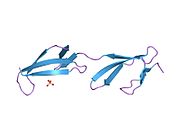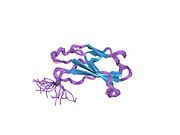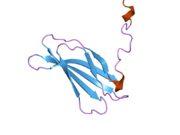Fibronectin

Fibronectinis a high-molecular weight(~500-~600kDa)[5]glycoproteinof theextracellular matrixthat binds tomembrane-spanningreceptor proteinscalledintegrins.[6]Fibronectin also binds to other extracellular matrix proteins such ascollagen,fibrin,andheparan sulfateproteoglycans(e.g.syndecans).
Fibronectin exists as aprotein dimer,consisting of two nearly identicalmonomerslinked by a pair ofdisulfide bonds.[6]The fibronectin protein is produced from a single gene, butalternative splicingof itspre-mRNAleads to the creation of severalisoforms.
Two types of fibronectin are present invertebrates:[6]
- soluble plasma fibronectin (formerly called "cold-insoluble globulin", or CIg) is a major protein component ofblood plasma(300 μg/ml) and is produced in theliverbyhepatocytes.
- insoluble cellular fibronectin is a major component of the extracellular matrix. It is secreted by variouscells,primarilyfibroblasts,as a solubleprotein dimerand is then assembled into an insoluble matrix in a complex cell-mediated process.
Fibronectin plays a major role incell adhesion,growth,migration,anddifferentiation,and it is important for processes such aswound healingandembryonic development.[6]Altered fibronectinexpression,degradation,and organization has been associated with a number ofpathologies,including cancer, arthritis, andfibrosis.[7][8]
Structure[edit]
Fibronectin exists as a protein dimer, consisting of two nearly identicalpolypeptidechains linked by a pair ofC-terminaldisulfide bonds.[9]Each fibronectinsubunithas a molecular weight of ~230–~275 kDa[10]and contains three types ofmodules:type I, II, and III. All three modules are composed of two anti-parallelβ-sheetsresulting in aBeta-sandwich;however,type Iandtype IIare stabilized by intra-chain disulfide bonds, whiletype IIImodules do not contain any disulfide bonds. The absence of disulfide bonds in type III modules allows them to partially unfold under applied force.[11]
Three regions of variablesplicingoccur along the length of the fibronectinprotomer.One or both of the "extra" type III modules (EIIIA and EIIIB) may be present in cellular fibronectin, but they are never present in plasma fibronectin. A "variable" V-region exists between III14–15(the 14th and 15th type III module). The V-region structure is different from the type I, II, and III modules, and its presence and length may vary. The V-region contains the binding site forα4β1integrins. It is present in most cellular fibronectin, but only one of the two subunits in a plasma fibronectin dimer contains a V-region sequence.
The modules are arranged into several functional andprotein-bindingdomainsalong the length of a fibronectinmonomer.There are four fibronectin-binding domains, allowing fibronectin to associate with other fibronectin molecules.[9]One of these fibronectin-binding domains, I1–5,is referred to as the "assembly domain", and it is required for the initiation of fibronectin matrix assembly. Modules III9–10correspond to the "cell-binding domain" of fibronectin. TheRGD sequence(Arg–Gly–Asp) is located in III10and is the site ofcell attachmentviaα5β1andαVβ3integrins on the cell surface. The "synergy site" is in III9and has a role in modulating fibronectin's association withα5β1integrins.[12]Fibronectin also contains domains forfibrin-binding (I1–5,I10–12),collagen-binding (I6–9),fibulin-1-binding (III13–14),heparin-binding andsyndecan-binding (III12–14).[9]
Function[edit]
Fibronectin has numerous functions that ensure the normal functioning ofvertebrateorganisms.[6]It is involved incell adhesion,growth,migration,anddifferentiation.Cellular fibronectin is assembled into theextracellular matrix,an insoluble network that separates and supports theorgansandtissuesof an organism.
Fibronectin plays a crucial role inwound healing.[13][14]Along withfibrin,plasmafibronectin is deposited at the site of injury, forming ablood clotthat stops bleeding and protects the underlyingtissue.As repair of the injured tissue continues,fibroblastsandmacrophagesbegin to remodel the area, degrading the proteins that form the provisionalblood clotmatrix and replacing them with amatrixthat more resembles the normal, surrounding tissue. Fibroblasts secreteproteases,includingmatrix metalloproteinases,that digest the plasma fibronectin, and then the fibroblasts secretecellularfibronectin and assemble it into an insolublematrix.Fragmentation of fibronectin by proteases has been suggested to promote wound contraction, a critical step inwound healing.Fragmenting fibronectin further exposes its V-region, which contains the site forα4β1integrinbinding. These fragments of fibronectin are believed to enhance the binding of α4β1 integrin-expressing cells, allowing them to adhere to and forcefully contract the surrounding matrix.
Fibronectin is necessary forembryogenesis,andinactivatingthegenefor fibronectin results in early embryonic lethality.[15]Fibronectin is important for guidingcell attachmentandmigrationduringembryonic development.Inmammaliandevelopment, the absence of fibronectin leads to defects inmesodermal,neural tube,andvasculardevelopment. Similarly, the absence of a normal fibronectin matrix in developingamphibianscauses defects inmesodermalpatterning and inhibitsgastrulation.[16]
Fibronectin is also found in normal human saliva, which helps preventcolonizationof theoral cavityandpharynxbypathogenic bacteria.[17]
Matrix assembly[edit]
Cellularfibronectin is assembled into aninsolublefibrillarmatrixin a complex cell-mediated process.[18]Fibronectin matrix assembly begins when soluble, compact fibronectindimersaresecretedfrom cells, oftenfibroblasts.These soluble dimers bind toα5β1integrinreceptors on the cell surface and aid in clustering the integrins. The localconcentrationof integrin-bound fibronectin increases, allowing bound fibronectinmoleculesto more readily interact with one another. Short fibronectinfibrilsthen begin to form between adjacent cells. As matrix assembly proceeds, the soluble fibrils are converted into larger insoluble fibrils that comprise theextracellular matrix.
Fibronectin's shift fromsolubleto insoluble fibrils proceeds when cryptic fibronectin-binding sites are exposed along the length of a bound fibronectin molecule. Cells are believed to stretch fibronectin by pulling on their fibronectin-bound integrin receptors. Thisforcepartially unfolds the fibronectinligand,unmasking cryptic fibronectin-binding sites and allowing nearby fibronectin molecules to associate. This fibronectin-fibronectin interaction enables the soluble, cell-associated fibrils to branch and stabilize into an insoluble fibronectinmatrix.
A transmembrane protein,CD93,has been shown to be essential for fibronectin matrix assembly (fibrillogenesis) in human dermal blood endothelial cells.[19]As a consequence, knockdown of CD93 in these cells resulted in the disruption of the fibronectin fibrillogenesis. Moreover, the CD93 knockout mice retinas displayed disrupted fibronectin matrix at the retinal sprouting front.[19]
Role in cancer[edit]
Several morphological changes has been observed intumorsand tumor-derivedcell linesthat have been attributed to decreased fibronectinexpression,increased fibronectindegradation,and/or decreasedexpressionof fibronectin-bindingreceptors,such asα5β1integrins.[20]
Fibronectin has been implicated incarcinomadevelopment.[21]Inlung carcinoma,fibronectinexpressionis increased especially innon-small cell lung carcinoma.Theadhesionof lung carcinoma cells to fibronectin enhancestumorigenicityand confersresistancetoapoptosis-inducingchemotherapeutic agents.Fibronectin has been shown to stimulate thegonadal steroidsthat interact withvertebrateandrogen receptors,which are capable of controlling theexpressionofcyclin Dand relatedgenesinvolved incell cyclecontrol. These observations suggest that fibronectin may promote lungtumor growth/survival and resistance to therapy, and it could represent a noveltargetfor the development of newanticancer drugs.
Fibronectin 1 acts as a potentialbiomarkerforradioresistance[22]and for pan-cancer prognosis.[23]
FN1-FGFR1 fusion is frequent in phosphaturic mesenchymal tumours.[24][25]
Role in wound healing[edit]
Fibronectin has profound effects onwound healing,including the formation of proper substratum for migration and growth of cells during the development and organization ofgranulation tissue,as well as remodeling and resynthesis of the connective tissue matrix.[26]The biological significance of fibronectinin vivowas studied during the mechanism of wound healing.[26]Plasma fibronectin levels are decreased in acute inflammation or following surgical trauma and in patients withdisseminated intravascular coagulation.[27]
Fibronectin is located in the extracellular matrix of embryonic and adult tissues (not in thebasement membranesof the adult tissues), but may be more widely distributed in inflammatory lesions. During blood clotting, the fibronectin remains associated with the clot, covalently cross-linked tofibrinwith the help ofFactor XIII(fibrin-stabilizing factor).[28][29]Fibroblastsplay a major role in wound healing by adhering to fibrin. Fibroblast adhesion to fibrin requires fibronectin, and was strongest when the fibronectin was cross-linked to the fibrin. Patients with Factor XIII deficiencies display impairment in wound healing as fibroblasts don't grow well in fibrin lacking Factor XIII. Fibronectin promotes particlephagocytosisby bothmacrophagesand fibroblasts. Collagen deposition at the wound site by fibroblasts takes place with the help of fibronectin. Fibronectin was also observed to be closely associated with the newly depositedcollagenfibrils. Based on the size andhistologicalstaining characteristics of the fibrils, it is likely that at least in part they are composed of type III collagen (reticulin). Anin vitrostudy with native collagen demonstrated that fibronectin binds to type III collagen rather than other types.[30]
In vivovsin vitro[edit]
Plasma fibronectin, which is synthesized byhepatocytes,[31]and fibronectin synthesized byculturedfibroblastsare similar but not identical; immunological, structural, and functional differences have been reported.[32]It is likely that these differences result from differential processing of a single nascent mRNA. Nevertheless, plasma fibronectin can be insolubilized into the tissueextracellular matrixin vitroandin vivo.Both plasma and cellular fibronectins in the matrix form high molecular weight,disulfide-bondedmultimers.The mechanism of formation of these multimers is not presently known. Plasma fibronectin has been shown to contain two freesulfhydrylsper subunit (X), and cellular fibronectin has been shown to contain at least one. These sulfhydryls probably are buried within thetertiary structure,because sulfhydryls are exposed when the fibronectin is denatured. Such denaturation results in the oxidation of free sulfhydryls and formation of disulfide-bonded fibronectin multimers. This has led to speculation that the free sulfhydryls may be involved in formation of disulfide-bonded fibronectin multimers in the extracellular matrix. Consistent with this, sulfhydryl modification of fibronectin withN-ethylmaleimideprevents binding to cell layers.Trypticcleavage patterns of multimeric fibronectin do not reveal the disulfide-bonded fragments that would be expected if multimerization involved one or both of the free sulfhydryls. The free sulfhydryls of fibronectin are not required for the binding of fibronectin to the cell layer or for its subsequent incorporation into the extracellular matrix. Disulfide-bonded multimerization of fibronectin in the cell layer occurs by disulfide bond exchange in the disulfide-richamino-terminalone-third of the molecule.[32]
Fibronectin genetic variation as a protective factor against Alzheimer's disease[edit]
A specific genetic variation in Fibronectin gene was shown to reduce the risk of developing Alzheimer's disease in a multicenter, multiethnic genetic epidemiology and functional genomics study. This effect is believed to be through enhancing the brain's ability to clear the toxic waste and protein accummulation through blood-brain-barrier.[33]
Interactions[edit]
Besides integrin, fibronectin binds to many other host and non-host molecules. For example, it has been shown to interact with proteins suchfibrin,tenascin,TNF-α, BMP-1, rotavirus NSP-4, and many fibronectin-binding proteins from bacteria (like FBP-A; FBP-B on the N-terminal domain), as well as theglycosaminoglycan,heparan sulfate.
Fibronectin has been shown tointeractwith:
See also[edit]
- Fetal fibronectin
- Fibronectin type I domain
- Fibronectin type II domain
- Fibronectin type III domain
- Monobody,an engineered antibody mimetic based on the structure of the fibronectin type III domain
- Substrate adhesion molecules
References[edit]
- ^abcGRCh38: Ensembl release 89: ENSG00000115414–Ensembl,May 2017
- ^abcGRCm38: Ensembl release 89: ENSMUSG00000026193–Ensembl,May 2017
- ^"Human PubMed Reference:".National Center for Biotechnology Information, U.S. National Library of Medicine.
- ^"Mouse PubMed Reference:".National Center for Biotechnology Information, U.S. National Library of Medicine.
- ^Mitrović S, Mitrović D, Todorović V (July 1995)."[Fibronectin--a multifunctional glycoprotein]".Srpski Arhiv Za Celokupno Lekarstvo.123(7–8): 198–201.ISSN0370-8179.PMID17974429.Archived fromthe originalon February 9, 2022.
- ^abcdePankov R, Yamada KM (October 2002)."Fibronectin at a glance".Journal of Cell Science.115(Pt 20): 3861–3.doi:10.1242/jcs.00059.PMID12244123.
- ^Williams CM, Engler AJ, Slone RD, Galante LL, Schwarzbauer JE (May 2008)."Fibronectin expression modulates mammary epithelial cell proliferation during acinar differentiation".Cancer Research.68(9): 3185–92.doi:10.1158/0008-5472.CAN-07-2673.PMC2748963.PMID18451144.
- ^Kragstrup TW, Sohn DH, Lepus CM, Onuma K, Wang Q, Robinson WH, Sokolove J (2019)."Fibroblast-like synovial cell production of extra domain A fibronectin associates with inflammation in osteoarthritis".BMC Rheumatology.3:46.doi:10.1186/s41927-019-0093-4.PMC6886182.PMID31819923.
- ^abcMao Y, Schwarzbauer JE (September 2005). "Fibronectin fibrillogenesis, a cell-mediated matrix assembly process".Matrix Biology.24(6): 389–99.doi:10.1016/j.matbio.2005.06.008.PMID16061370.
- ^Sitterley G."Fibronectin".Sigma Aldrich.
- ^Erickson HP (2002). "Stretching fibronectin".Journal of Muscle Research and Cell Motility.23(5–6): 575–80.doi:10.1023/A:1023427026818.PMID12785106.S2CID7052723.
- ^Sechler JL, Corbett SA, Schwarzbauer JE (December 1997)."Modulatory roles for integrin activation and the synergy site of fibronectin during matrix assembly".Molecular Biology of the Cell.8(12): 2563–73.doi:10.1091/mbc.8.12.2563.PMC25728.PMID9398676.
- ^Grinnell F (1984). "Fibronectin and wound healing".Journal of Cellular Biochemistry.26(2): 107–116.doi:10.1002/jcb.240260206.PMID6084665.S2CID28645109.
- ^Valenick LV, Hsia HC, Schwarzbauer JE (September 2005). "Fibronectin fragmentation promotes alpha4beta1 integrin-mediated contraction of a fibrin-fibronectin provisional matrix".Experimental Cell Research.309(1): 48–55.doi:10.1016/j.yexcr.2005.05.024.PMID15992798.
- ^George EL, Georges-Labouesse EN, Patel-King RS, Rayburn H, Hynes RO (December 1993)."Defects in mesoderm, neural tube and vascular development in mouse embryos lacking fibronectin".Development.119(4): 1079–91.doi:10.1242/dev.119.4.1079.PMID8306876.
- ^Darribère T, Schwarzbauer JE (April 2000). "Fibronectin matrix composition and organization can regulate cell migration during amphibian development".Mechanisms of Development.92(2): 239–50.doi:10.1016/S0925-4773(00)00245-8.PMID10727862.S2CID2640979.
- ^Hasty DL, Simpson WA (September 1987)."Effects of fibronectin and other salivary macromolecules on the adherence of Escherichia coli to buccal epithelial cells".Infection and Immunity.55(9): 2103–9.doi:10.1128/IAI.55.9.2103-2109.1987.PMC260663.PMID3305363.
- ^Wierzbicka-Patynowski I, Schwarzbauer JE (August 2003). "The ins and outs of fibronectin matrix assembly".Journal of Cell Science.116(Pt 16): 3269–76.doi:10.1242/jcs.00670.PMID12857786.S2CID16975447.
- ^abLugano R, Vemuri K, Yu D, Bergqvist M, Smits A, Essand M, Johansson S, Dejana E, Dimberg A (August 2018)."CD93 promotes β1 integrin activation and fibronectin fibrillogenesis during tumor angiogenesis".The Journal of Clinical Investigation.128(8): 3280–3297.doi:10.1172/JCI97459.PMC6063507.PMID29763414.
- ^Hynes, Richard O. (1990).Fibronectins.Berlin: Springer-Verlag.ISBN978-0-387-97050-9.
- ^Han S, Khuri FR, Roman J (January 2006)."Fibronectin stimulates non-small cell lung carcinoma cell growth through activation of Akt/mammalian target of rapamycin/S6 kinase and inactivation of LKB1/AMP-activated protein kinase signal pathways".Cancer Research.66(1): 315–23.doi:10.1158/0008-5472.CAN-05-2367.PMID16397245.
- ^Jerhammar F, Ceder R, Garvin S, Grénman R, Grafström RC, Roberg K (December 2010)."Fibronectin 1 is a potential biomarker for radioresistance in head and neck squamous cell carcinoma".Cancer Biology & Therapy.10(12): 1244–1251.doi:10.4161/cbt.10.12.13432.PMID20930522.
- ^Chicco D, Alameer A, Rahmati S, Jurman G (November 3, 2022)."Towards a potential pan-cancer prognostic signature for gene expression based on probesets and ensemble machine learning".BioData Mining.15(1): 28.doi:10.1186/s13040-022-00312-y.eISSN1756-0381.PMC9632055.PMID36329531.
- ^Wasserman JK, Purgina B, Lai CK, Gravel D, Mahaffey A, Bell D, Chiosea SI (January 2016)."Phosphaturic Mesenchymal Tumor Involving the Head and Neck: A Report of Five Cases with FGFR1 Fluorescence In Situ Hybridization Analysis".Head and Neck Pathology.10(3): 279–85.doi:10.1007/s12105-015-0678-1.PMC4972751.PMID26759148.
- ^Lee JC, Jeng YM, Su SY, Wu CT, Tsai KS, Lee CH, Lin CY, Carter JM, Huang JW, Chen SH, Shih SR, Mariño-Enríquez A, Chen CC, Folpe AL, Chang YL, Liang CW (March 2015). "Identification of a novel FN1-FGFR1 genetic fusion as a frequent event in phosphaturic mesenchymal tumour".The Journal of Pathology.235(4): 539–45.doi:10.1002/path.4465.PMID25319834.S2CID9887919.
- ^abGrinnell F, Billingham RE, Burgess L (March 1981)."Distribution of fibronectin during wound healing in vivo".The Journal of Investigative Dermatology.76(3): 181–189.doi:10.1111/1523-1747.ep12525694.PMID7240787.
- ^Bruhn HD, Heimburger N (1976). "Factor-VIII-related antigen and cold-insoluble globulin in leukemias and carcinomas".Haemostasis.5(3): 189–192.doi:10.1159/000214134.PMID1002003.
- ^Mosher DF (August 1975)."Cross-linking of cold-insoluble globulin by fibrin-stabilizing factor".The Journal of Biological Chemistry.250(16): 6614–6621.doi:10.1016/S0021-9258(19)41110-1.PMID1158872.
- ^Mosher DF (March 1976)."Action of fibrin-stabilizing factor on cold-insoluble globulin and alpha2-macroglobulin in clotting plasma".The Journal of Biological Chemistry.251(6): 1639–1645.doi:10.1016/S0021-9258(17)33696-7.PMID56335.
- ^Engvall E, Ruoslahti E, Miller EJ (June 1978)."Affinity of fibronectin to collagens of different genetic types and to fibrinogen".The Journal of Experimental Medicine.147(6): 1584–1595.doi:10.1084/jem.147.6.1584.PMC2184308.PMID567240.
- ^Tamkun JW, Hynes RO (April 1983)."Plasma fibronectin is synthesized and secreted by hepatocytes".The Journal of Biological Chemistry.258(7): 4641–7.doi:10.1016/S0021-9258(18)32672-3.PMID6339502.
- ^abMcKeown-Longo PJ, Mosher DF (October 1984)."Mechanism of formation of disulfide-bonded multimers of plasma fibronectin in cell layers of cultured human fibroblasts".The Journal of Biological Chemistry.259(19): 12210–12215.doi:10.1016/S0021-9258(20)71340-2.PMID6480605.
- ^Bhattarai P, Gunasekaran TI, Belloy ME, Reyes-Dumeyer D, Jülich D, Tayran H, Yilmaz E, Flaherty D, Turgutalp B, Sukumar G, Alba C, McGrath EM, Hupalo DN, Bacikova D, Le Guen Y, Lantigua R, Medrano M, Rivera D, Recio P, Nuriel T, Ertekin-Taner N, Teich AF, Dickson DW, Holley S, Greicius M, Dalgard CL, Zody M, Mayeux R, Kizil C, Vardarajan BN (April 2024)."Rare genetic variation in fibronectin 1 (FN1) protects against APOEε4 in Alzheimer's disease".Acta Neuropathologica.147(1): 70.doi:10.1007/s00401-024-02721-1.PMC11006751.PMID38598053.
- ^Jalkanen S, Jalkanen M (February 1992)."Lymphocyte CD44 binds the COOH-terminal heparin-binding domain of fibronectin".The Journal of Cell Biology.116(3): 817–25.doi:10.1083/jcb.116.3.817.PMC2289325.PMID1730778.
- ^Lapiere JC, Chen JD, Iwasaki T, Hu L, Uitto J, Woodley DT (November 1994). "Type VII collagen specifically binds fibronectin via a unique subdomain within the collagenous triple helix".The Journal of Investigative Dermatology.103(5): 637–41.doi:10.1111/1523-1747.ep12398270.PMID7963647.
- ^Chen M, Marinkovich MP, Veis A, Cai X, Rao CN, O'Toole EA, Woodley DT (June 1997)."Interactions of the amino-terminal noncollagenous (NC1) domain of type VII collagen with extracellular matrix components. A potential role in epidermal-dermal adherence in human skin".The Journal of Biological Chemistry.272(23): 14516–22.doi:10.1074/jbc.272.23.14516.PMID9169408.
- ^Salonen EM, Jauhiainen M, Zardi L, Vaheri A, Ehnholm C (December 1989)."Lipoprotein(a) binds to fibronectin and has serine proteinase activity capable of cleaving it".The EMBO Journal.8(13): 4035–40.doi:10.1002/j.1460-2075.1989.tb08586.x.PMC401578.PMID2531657.
- ^Martin JA, Miller BA, Scherb MB, Lembke LA, Buckwalter JA (July 2002)."Co-localization of insulin-like growth factor binding protein 3 and fibronectin in human articular cartilage".Osteoarthritis and Cartilage.10(7): 556–63.doi:10.1053/joca.2002.0791.PMID12127836.
- ^Gui Y, Murphy LJ (May 2001)."Insulin-like growth factor (IGF)-binding protein-3 (IGFBP-3) binds to fibronectin (FN): demonstration of IGF-I/IGFBP-3/fn ternary complexes in human plasma".The Journal of Clinical Endocrinology and Metabolism.86(5): 2104–10.doi:10.1210/jcem.86.5.7472.PMID11344214.
- ^Chung CY, Zardi L, Erickson HP (December 1995)."Binding of tenascin-C to soluble fibronectin and matrix fibrils".The Journal of Biological Chemistry.270(48): 29012–7.doi:10.1074/jbc.270.48.29012.PMID7499434.
- ^Zhou Y, Li L, Liu Q, Xing G, Kuai X, Sun J, Yin X, Wang J, Zhang L, He F (May 2008). "E3 ubiquitin ligase SIAH1 mediates ubiquitination and degradation of TRB3".Cellular Signalling.20(5): 942–8.doi:10.1016/j.cellsig.2008.01.010.PMID18276110.
Further reading[edit]
- ffrench-Constant C (December 1995). "Alternative splicing of fibronectin--many different proteins but few different functions".Experimental Cell Research.221(2): 261–71.doi:10.1006/excr.1995.1374.PMID7493623.
- Snásel J, Pichová I (1997). "The cleavage of host cell proteins by HIV-1 protease".Folia Biologica.42(5): 227–30.doi:10.1007/BF02818986.PMID8997639.S2CID7617882.
- Schor SL, Schor AM (2003)."Phenotypic and genetic alterations in mammary stroma: implications for tumour progression".Breast Cancer Research.3(6): 373–9.doi:10.1186/bcr325.PMC138703.PMID11737888.
- Przybysz M, Katnik-Prastowska I (2002). "[Multifunction of fibronectin]" [Multifunction of fibronectin].Postȩpy Higieny I Medycyny Doświadczalnej(in Polish).55(5): 699–713.PMID11795204.
- Rameshwar P, Oh HS, Yook C, Gascon P, Chang VT (2003). "Substance p-fibronectin-cytokine interactions in myeloproliferative disorders with bone marrow fibrosis".Acta Haematologica.109(1): 1–10.doi:10.1159/000067268.PMID12486316.S2CID25830801.
- Cho J, Mosher DF (July 2006)."Role of fibronectin assembly in platelet thrombus formation".Journal of Thrombosis and Haemostasis.4(7): 1461–9.doi:10.1111/j.1538-7836.2006.01943.x.PMID16839338.S2CID24109462.
- Schmidt DR, Kao WJ (January 2007). "The interrelated role of fibronectin and interleukin-1 in biomaterial-modulated macrophage function".Biomaterials.28(3): 371–82.doi:10.1016/j.biomaterials.2006.08.041.PMID16978691.
- Dallas SL, Chen Q, Sivakumar P (2006).Dynamics of assembly and reorganization of extracellular matrix proteins.Vol. 75. pp. 1–24.doi:10.1016/S0070-2153(06)75001-3.ISBN9780121531751.PMID16984808.
{{cite book}}:|journal=ignored (help)
External links[edit]
- Fibronectin, an Extracellular Adhesion Molecule
- The Fibronectin ProteinArchivedMarch 10, 2022, at theWayback Machine
- Fibronectinat the U.S. National Library of MedicineMedical Subject Headings(MeSH)
- Fibronectin molecular interactions
- Overview of all the structural information available in thePDBforUniProt:P02751(Human Fibronectin) at thePDBe-KB.
- Overview of all the structural information available in thePDBforUniProt:P11276(Mouse Fibronectin) at thePDBe-KB.







